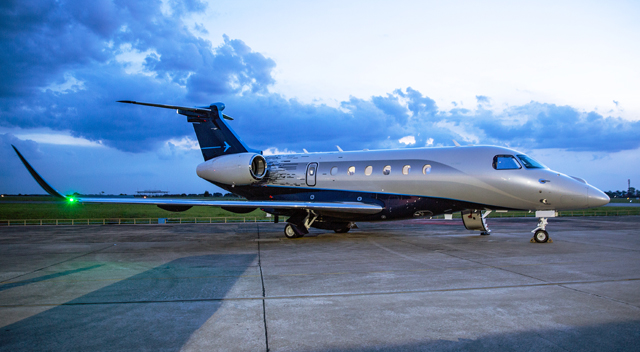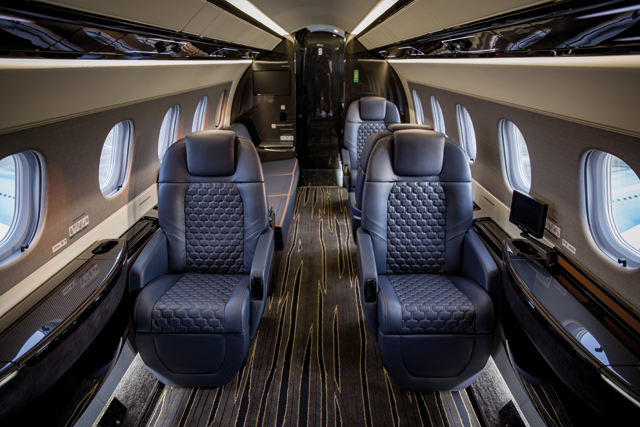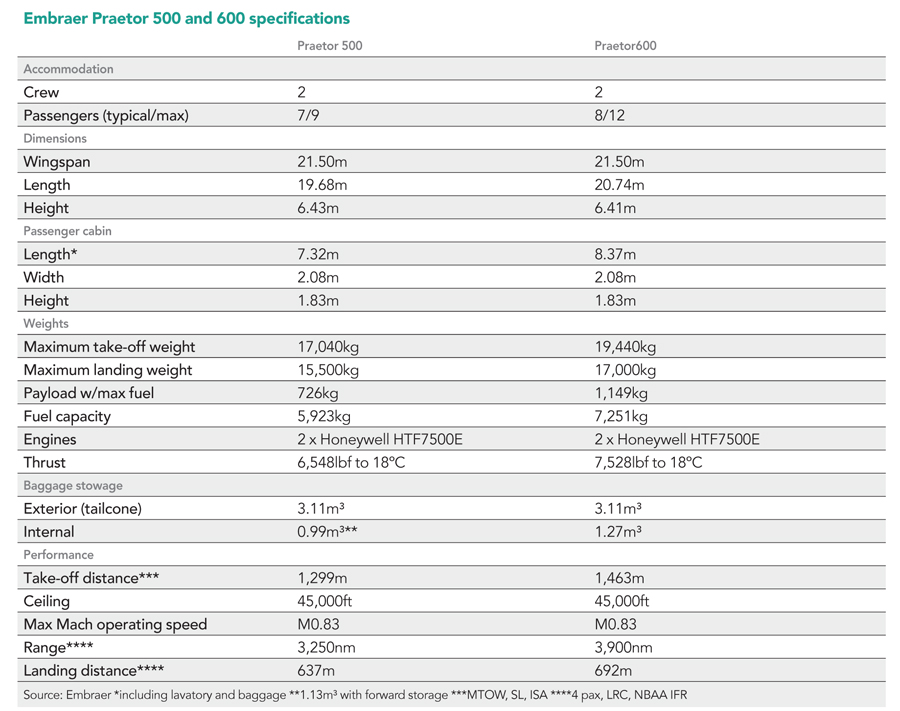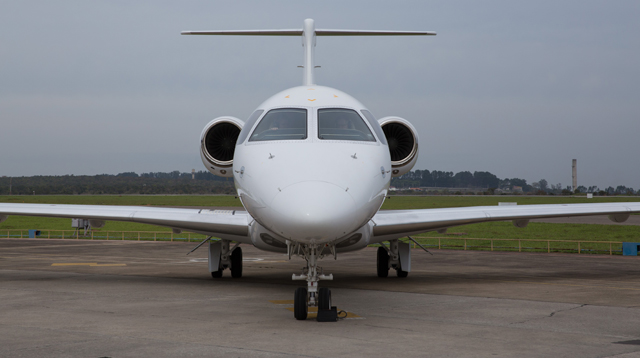Brazilian airframer Embraer will celebrate its 50th anniversary next year. Its first three decades were focused on military and civil transport offerings, but the beginning of the 21st Century saw it test the business jet market waters with the Legacy Executive, later renamed the Legacy 600.
Based on the ERJ-135; itself a derivative of the company’s highly successful ERJ-145 regional jet, the super-midsize Legacy 600 and longer-range 650 have been a big success, with nearly 300 aircraft delivered. But while the 600/650 were successful, deliveries were matched by the Gulfstream G280/Israel Aerospace Industries Galaxy line, and more than doubled by Bombardier’s Challenger 300/350 series.

Additional fuel capacity brings the Praetor 600’s MTOW to 19,449kg
Embraer
Embraer next concentrated its efforts on the entry/light segment when it fielded the wildly successful Phenom 100 and 300 models. In 2007, it went upmarket to launch the Legacy 450 and 500, respectively designed to gain a foothold in the midsize sector and expand its market share in the super-midsize segment. While the Legacy 450/500 models have enjoyed moderate sales success – with nearly 100 units delivered – their significance is perhaps better measured by technological prowess, notably a full fly-by-wire control system on a Mach 0.80 cruise, stand-up-cabin aircraft. Formerly only available on large-cabin business jets, FBW control systems have been shown to reduce maintenance costs, improve flying qualities and enhance safety. The Legacy 450/500 were true market disruptors, offering all this capability for only $17 million and $20 million, respectively.
Nearly three years ago, FlightGlobal flew both the Legacy 450 and 500. I was very impressed by Embraer’s first full FBW aircraft, writing at the time: “Owners will appreciate the 450’s low direct operating costs, passengers the quiet stand-up cabin, and pilots the crisp, care-free handling qualities of this paradigm-shifting fly-by-wire business jet.” From a performance standpoint, their only real shortcoming was range, compared with some competitors.
Branding is another matter. Despite offering outstanding products, Embraer is not well known outside of aviation, and when it entered the business jet market it tried to differentiate itself by calling its offerings “Executive” Jets and to use family brand names for specific market segment offerings: Phenom for the entry/light segment, Legacy for midsize and super-midsize types, and Lineage for the super-large market. Cessna, Dassault and Gulfstream, by contrast, may deploy more coherent product nomenclature, with all their business jets prefixed with “Citation”, “Falcon”, and “G”, respectively. For a little-known company competing against established rivals in a splintered and highly discretionary market, the brand challenge is not trivial. It was against this backdrop that FlightGlobal was recently invited to Embraer’s São José dos Campos headquarters to fly a previously undisclosed business jet.
LONG-RANGE GOALS
Prior to the flight, executive jet product strategy manager Alvadi Serpa revealed the preview aircraft to FlightGlobal as the Praetor 500 and 600 by Embraer. These new aircraft promise significant range improvements over the Legacy 450 and 500, of which they are clearly derivatives. In addition, the pair launch the “Praetor” brand, which Embraer hopes will better resonate in the marketplace. Embraer says its Praetor is a loyal, highly capable servant that speeds its owner across the globe in comfort. I did some research on what a Praetor was and what qualities it would imply for a business aircraft, but lacking training in the Classics, I thought it best to let the Praetor reveal itself during my preview flight.

Gerzanics (centre right), Sydney Rodrigues (centre left) and crew
Embraer
As mentioned earlier, the biggest improvement the Praetors bring to market is their increased range and payload over their Legacy predecessors. With four passengers and NBAA IFR reserves the smaller Praetor 500 has a 350nm (648km) range advantage, while the Praetor 600 has an even greater, 775nm bump in performance. Additional fuel is the elixir that gives these jets their continent- and ocean-spanning ranges.
All four aircraft, inboard of the winglets, share a common structure, save the strengthening required for the Praetor’s larger winglets. Embraer increased the fuel capacity in the Praetor 500 by 431kg (980lb) compared with the Legacy 450, primarily by changing fuel tank limit shut-off levels. The Praetor 600’s 1,328kg fuel advantage over the Legacy 500 took a little more engineering.
Two auxiliary tanks were added on the belly of the aircraft, enclosed by an enlarged composite wing-to-body fairing. Their location required the addition of a ventral fin, similar to that on the Legacy 600/650, to protect the fuel tanks in the event of a gear-up landing. Payload for the Praetor 600 is 1,815kg, an increase of 545kg over the Legacy 500. Fully fuelled, a Praetor 500 can carry eight passengers, compared with just four for the Legacy 450.
To mitigate the weight of the extra fuel, larger winglets were added to both Praetor models. They are 0.57m (1ft 10in) higher than those on the Legacy and add 1.25m to its wingspan. Primarily made of aluminium, they are retrofittable to the Legacy 450/500. The additional weight also required minor modifications to the digital flight control system for both models.

Larger winglets compensate for added fuel weight
Embraer
The Praetor 600’s extra fuel and tanks raises its maximum take-off weight to 19,449kg: 2,040kg more than the Legacy 500. The Praetor 500’s MTOW is only 760kg greater than the Legacy 450’s. To mitigate increased wing root loads on the heavier Praetor without further structural modifications, Embraer has incorporated a manoeuvre load alleviation scheme for the ailerons. This approach is similar to that employed by Boeing on its 737NG, where FBW spoilers are used to reduce loads. This load alleviation capability reduces structural weight and highlights one of the many benefits offered by FBW control systems.
The Praetor 600’s extra weight also dictated an increase in thrust. While it still uses Honeywell HTF7500E-series engines, those on the Praetor 600 have a maximum thrust rating of 7,528lb (33.5kN), a nearly 7% increase over the Legacy 500. In a nod to the importance of connectivity, the Praetors will be the smallest business jets to offer Ka-band ultra-high-speed internet. Improvements to the Rockwell Collins Pro Line Fusion flightdeck and passenger cabin amenities round out the notable upgrades.
Our preview aircraft was the second Praetor 600 prototype, PT-ZSU, which first flew in April 2018. Built as a Legacy 500, it was subsequently modified into the new model’s configuration. While it had flight-test equipment in the cabin, it was production-representative from a performance, flying qualities and systems standpoint. Externally, it lacked the production aircraft’s T-tail-mounted ViaSat Ka-band radome and antenna.
Prior to my flight I familiarised myself with a production Praetor 600’s passenger cabin, which featured a “Bossa Nova” design style. As can be expected I found it quite welcoming, with fit and finish details on a par with those found on large-cabin jets. While the safety pilot, Captain Eduardo Rodrigues, conducted the external walk-around inspection on Embraer’s ramp at São José dos Campos, I strapped into the Praetor’s left seat. Once seated, I helped Captain Sydney Rodrigues (no relation) initialise the flight management system and perform pre-start checks.

Cabin interior allows passengers to travel in comfort
Embraer
The electronic checklist was used to confirm completion of required items. I especially liked that it was a smart checklist with automatic sensing for some items. Auxiliary power unit bleed air was used to start the engines. The FADEC-controlled start sequence was straightforward and quick, with less than 30s needed for each engine to stabilise at IDLE.
During the taxi to runway 15 for departure, I liked the Praetor’s precise pedal-controlled nosewheel steering – there being no space for a conventional tiller. Prior to taking the runway, Rodrigues pushed the centre console mounted TO CONFIG button, the aural “Take-off OK” confirming we were in a proper configuration. Once cleared for take-off, I advanced the thrust levers, with the auto-throttles set at 93.2% N1 take-off/go-around thrust for test day conditions. Rodrigues called “Rotate” at 115kt (213km/h) indicated airspeed (KIAS), and less than 5kg of aft sidestick pressure was needed to rotate the Praetor to 10˚ for take-off.
Sidestick forces in pitch during clean-up and acceleration were zero, the pitch rate command system compensating for changing conditions. Once in a clean configuration, the Praetor was turned towards our working area over the Atlantic, just off Brazil’s coast. During the transit, Rodrigues enabled the cockpit display of traffic information feature of the avionics. This is Collins’ version of automatic dependent surveillance – broadcast in, which shows enhanced traffic information on the display.

Gerzanics and Rodrigues ready the jet for take-off
Embraer
With valid inputs targets are shown as arrows that point in the direction of travel, enhancing situational awareness. The cruise portion also gave me time to look at the vertical display capability of the new RTA-4218 weather radar. Cross-sectional views of convective activity are displayed on the vertical situation display, which is a great aid for route deviation decisions. The radar also has a predictive windshear capability – an outstanding safety enhancement.
ENVELOPE PROTECTIONS REVISITED
During my first flight in the Legacy 450, I was able to quite extensively sample the envelope protection features its FBW control system offered. On my flight in the larger, longer-range Praetor 600, I sampled a smaller set of these same features.
First, protection schemes at both ends of the speed spectrum were again tested. At the limits, the Praetor’s pitch axis flight control laws change with the addition of apparent speed stability. At low speed, aft sidestick must be held to slow below the top of the yellow band (1.08 VS). At the high end, once past VMO/MMO, no amount of forward sidestick pressure will lower the nose.
Roll axis limits were also examined. At angles of bank less than 33˚, the Praetor demonstrates neutral spiral stability, and the aircraft will maintain a set angle with no sidestick pressure. At an angle greater than 33˚, release of lateral sidestick pressure will cause the Praetor to roll back to and maintain 33˚. To further ease pilot workload, Embraer has put an automatic pitch compensation feature into the control laws. At an angle of bank of 30˚ or less, no aft sidestick pressure is needed to maintain pitch attitude.
An engine failure, particularly at low speed and altitude, is perhaps one of the most challenging situations the pilot of a multi-engined type can face. The Praetor has the same thrust asymmetry transient reduction scheme employed in the Legacy. Embraer designed it to allow for pilot recognition of the failure, while also reducing the chances of things going wrong if they do not.
At 13,000ft with 93.9% N1 set, Rodrigues rapidly pulled the left thrust lever to IDLE. The flight control laws sensed the thrust asymmetry and reduced the amount of allowed sideslip. With my feet and hands off the controls, the left wing dropped less than 5˚, and a steady sideslip angle of less than 3˚ developed. This same exercise was then conducted for a simulated right engine failure, again with the same benign result. The Praetor’s slow and moderated response to an engine failure will stack the deck in the pilot’s favour for a safe recovery from what could otherwise be a catastrophic event.
FUEL SYSTEM LOGIC
After we had completed the demonstration of protection features, we climbed the Praetor up to 28,000ft, where the operation of its larger fuel system was demonstrated. As detailed previously, the biggest difference between the Legacy 500 and the Praetor 600 is provision for an extra 1,328kg of fuel. Housed in two belly tanks (forward and ventral), the extra fuel increases range, but Embraer has also taken steps to further optimise this.

Normal fuel system operation is essentially automatic; fuel is always fed from wing tanks to the engines and transferred from the auxiliary tanks first. What is neat on the Praetor is that forward auxiliary tank fuel is transferred to the wing tanks first, followed by the ventral (aft) auxiliary tank. This scheme stands out because it keeps the centre of gravity as far aft as possible. An aft centre of gravity helps increase range by reducing drag from the horizontal stabiliser. During our short time at altitude I observed system function on the fuel synoptic page. To ensure proper system operation, transfer is inhibited at pitch attitude greater than +6˚ or less than -2˚. Several climbs and dives did indeed show transfer stopping when attitude limits were exceeded.
SYNTHETIC VISION APPROACH
With convective activity in the forecast, we concluded our area work and turned towards São José dos Campos. During our return I was able to exercise the graphical flight planning feature of the Pro Line Fusion flightdeck. Using the console-mounted cursor control device I was able to define and execute a route that avoided convective activity en route to the initial approach fix (LONES) for the instrument landing system to runway 15. While the charted procedure is a “plain vanilla” Cat 1 ILS, we would fly it in visual meteorological conditions as a synthetic vision guidance system (SVGS) approach. Defined by US Federal Aviation Administration AC 20-185 (December 2015), SVGS operates under satellite-based augmentation system coverage in CAT I SA airports.
The combination of the synthetic vision system, flight guidance display and high-precision position monitors provide a continuous geo-spatial depiction of the external topography, allowing decision height to be reduced from 200ft radio altitude (RA) to 150ft RA. This approach credit is available without a head-up display or guidance system and with training requirements similar to a regular CAT 1 ILS.
We were fully configured (gear down and flaps full) on the localiser just prior to starting down the glideslope. In a landing configuration, artificial speed stability is added in pitch, just like on the Legacy 450/500. Slowing to target speed (126KIAS) required resetting the trim control speed, via the sidestick-mounted switch, to nullify sidestick forces. The synthetic vision system display, while still a head-down display, is more like a head-up display than a conventional primary flight display.

Embraer
Its single-cue guidance symbol allowed me to accurately track both the localiser and glideslope. I especially liked the airspeed caret, which made holding target speed a snap. At 800ft above ground level the synthetic vision display’s horizon line shifted upwards, to provide a larger “view” of the runway and approach environment. At 150ft RA, “minimums” was announced, and I looked up to see us ideally situated to complete the approach to a smooth landing.
The taxi back to Embraer’s ramp and shutdown were uneventful, the 1h 20min block-to-block flight having just whetted my appetite to the joys of flying Embraer’s newest super-midsize type.
I have come to fully appreciate Embraer’s approach to FBW control systems. They demonstrate good flying qualities, while striking a fine balance between protection schemes and pilot primacy. While not clean-sheet designs, the Praetor 500 and 600 still need to complete flight-test campaigns prior to certification. Embraer is looking to field the Praetor 600 in the second quarter of 2019, followed by the 500 in the third quarter. Given the maturity of the Legacy 500 family and Embraer’s proven capabilities, these targets seem well within its reach.
For all the coverage from NBAA check out our dedicated event page
Source: Flight International






















